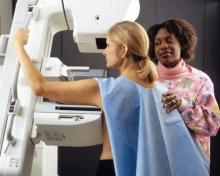In regions where more women undergo screening mammography, the detection of small cancers increases but mortality doesn’t change significantly, compared with regions where fewer women have the screening, according to a report published July 6 in JAMA Internal Medicine.
The finding indicates that screening mammography leads to “widespread overdiagnosis,” identifying many small, indolent, or regressive breast tumors that otherwise would not have become clinically apparent, reported Charles Harding, a data scientist and statistical analyst in Seattle, and his associates.
Ideally, screening mammography should result in increased detection of small (less advanced) cancers, decreased detection of large (more advanced) cancers, and reduced breast cancer–specific mortality. To examine whether this is what actually happens, Mr. Harding and his colleagues analyzed mammography rates among 16,120,349 women over age 40 residing in 547 counties across the country during a 1-year period, where the frequency of screening ranged from 39% to 78%.
They correlated these findings with breast cancer incidence and mortality data in those regions for the ensuing 10 years. They identified 53,207 incident cases of breast cancer for their primary analysis.
There was a clear correlation between the number of users of screening mammography and breast cancer incidence. A 10% increase in screening was associated with a 16% mean increase in breast cancer incidence (relative risk, 1.16), or an absolute increase of 35-49 cases per 100,000. However, there was no significant change in breast cancer mortality (RR, 1.01).
When the data were stratified according to tumor size, the researchers found that the increase in breast cancer was confined to small tumors only (2 cm or less).
Moreover, “although it has been hoped that screening would allow breast-conserving surgical procedures to replace more extensive mastectomies, we saw no evidence supporting this change,” the investigators wrote (JAMA Intern. Med. 2015 July 6 [doi:10.1001/jamainternmed.2015.3043]).
Future research should focus on whether all women undergoing screening mammography have the same risk of overdiagnosis, or if overdiagnosis is more likely to occur in certain groups, Mr. Harding and his associates added.
Mr. Harding reported receiving funding from Exergen Corporation for this work. Another study author, Francesco Pompei, Ph.D., is founder and chief executive officer of Exergen. Exergen is a designer and manufacturer of medical and other devices. No other financial disclosures were reported.


